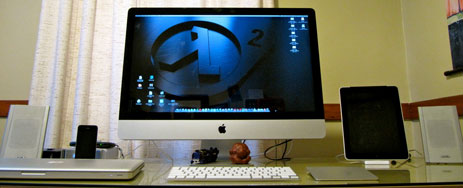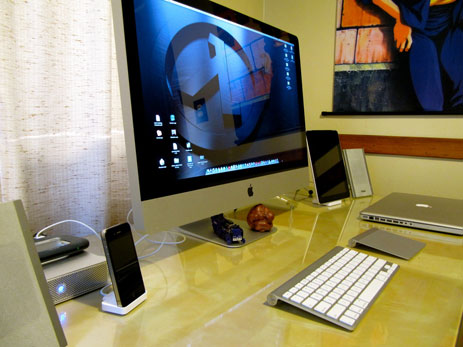Who are you, what do you do, etc…?
I am David Chartier, an Associate Editor at Macworld. I write about all things Apple, its products, and the third-party ecosystem that helps to make its products great. I also write about tech news and culture at onefps.net, and tweet at @chartier.
What is your current setup?


My primary machine is a late 2009 27-inch 2.66 GHz Core i5 iMac that could eat small family pets alive if left unchecked. I have a wireless Apple keyboard and a Magic Trackpad which is probably going to replace my Magic Mouse. My iMac’s partner in crime is a mid-2009 17-inch 2.8 GHz Core 2 Duo MacBook Pro. I have a 64GB iPad WiFi + 3G that I am increasingly using to write pieces (like this one), and an iPhone 4 that is almost never out of my arm’s reach. I also have a 2TB Time Capsule, an 802.11n AirPort Express, a 160GB Apple TV, a Logitech G9 mouse for gaming, and my wife has my old late 2008, first-gen aluminum unibody MacBook (before they went “Pro” and got an SD slot). I know, we’re the shrink-wrapped Apple family. I’ve had to find a way to live with it.
Why this rig?
I love screen real estate. I rarely full-screen apps, so when I’m writing I’ll give my browser, word processor, a chat window or two, any e-mail I need for reference, and other things as much balanced screen space as possible so I don’t need to switch between them to move information back and forth. Some techie friends consider the 17-inch MacBook Pro to be the aircraft carrier of Apple’s portables, but I love having all that space on-the-go when I need to use all those resources for pseudo-multitasking.
What software do you use and for what do you use it?
I have a ton of third-party apps, many of which I use infrequently for tasks like video transcoding or uploading photos to multiple services at once. But if I had to start with the fundamentals for writing at Macworld, I use MacJournal for almost every post, Skitch and Acorn for editing photos, and Safari. For communication I use Mail with MobileMe and Macworld Google Apps accounts, Adium for when I’m not slingshotting back to iChat (until I give in and want to use Facebook or Yahoo chat again), and Propane for the Macworld chat rooms that run on 37signals’ Campfire.
To keep track of story ideas and leads I use a mix of OmniFocus (after my nearly finished exodus from Things), Evernote, and Mail. I also have a few menubar utilities, though I’m trying to be a little more discerning about those lately. I use LaunchBar for lots of productivity stuff like launching apps and creating new e-mails and iCal events, CoverSutra for controlling iTunes, and Divvy for keeping all my windows in their places.
I’m trying to work LittleSnapper into my Macworld process so I can keep original images around for when editors need them for print. I use Time Machine to backup my Macs and my wife’s MacBook to the Time Capsule, ChronoSync to backup key files and media to a secondary external 2TB drive, and CrashPlan as a third layer of remote redundancy.
How does this setup help you do your best creative work?
I love to look at the big picture whether I work at home or on-the-go, which is why I keep lots of resources available at a quick glance and why I use MacJournal. It’s the only Mac word processor I can find which lets me draft in rich text, but copy to the clipboard as the perfectly formatted, plain HTML that most CMSes want. Lots of my peers pen in HTML or Markdown, but I don’t like to look at code or URLs when I write. To me, code is code, and prose is prose. I want to draft, re-read, and continue drafting a piece as the reader will see it, watching for things like the visual flow of text and too many concurrent links that can weigh a paragraph down.
With a desktop, a notebook, and now a tablet, I have a good array of choices between power and portability. I can bang out work and pseudo-multitask at home with my iMac and on-the-go with my MacBook Pro. Or I can bring my iPad out for the day and weekend getaways and focus on one task at a time while lying on the couch or in the middle of Millennium Park.
How would your ideal setup look and function?
I hope this doesn’t mean that I fail the Shawn Blanc Geek Test, but excluding my desire for the latest and fastest hardware, I’m not itching to make major changes. However, now that the 15-inch MacBook Pro has a higher resolution display and can switch graphics cards on the fly, I’m going to downsize and save some weight. I had a Mac Pro with dual Samsung displays for a couple years (22-inch and 24-inch), and while that was a sweet setup, I find that I like having one large, high-res workspace better.
As for the iPad, OS 4.0 and multitasking cannot arrive soon enough, but it really needs at least 512MB of RAM, if not more. I’ll probably upgrade immediately when (but only if) Apple revs the RAM (though possibly at a smaller storage capacity; I’m barely pushing 32GB on this one), because I’m not that desperate for a camera.
Speaking as a reformed mobile phone junkie, the iPhone 4 is the first phone I’ve been thoroughly happy with in years. The antenna thing doesn’t really bug me because I don’t hold it that way. The iPhone 5 will have to have some serious unicorn tear polish to get me to upgrade.
The only other changes to my setup would be more gear mostly for pleasure, not business. Mobile is exploding right now, so I’d love to pick up some Androids and Pres so I could learn a lot more about what they’re up to, but mostly for curiosity and work purposes. I’m also a frequent PC gamer, so I hope to build a dedicated PC again in the next few months. Boot Camp is wearing on me, and Steam for Mac seems like it’s going to need some time to pick up… momentum.
More Sweet Setups
David’s setup is just one in a series of sweet Mac Setups.

